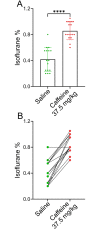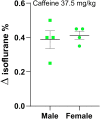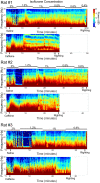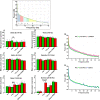Caffeine reverses the unconsciousness produced by light anesthesia in the continued presence of isoflurane in rats
- PMID: 33152041
- PMCID: PMC7643991
- DOI: 10.1371/journal.pone.0241818
Caffeine reverses the unconsciousness produced by light anesthesia in the continued presence of isoflurane in rats
Abstract
Currently no drugs are employed clinically to reverse the unconsciousness induced by general anesthetics. Our previous studies showed that caffeine, when given near the end of an anesthesia session, accelerated emergence from isoflurane anesthesia, likely caused by caffeine's ability to elevate intracellular cAMP levels and to block adenosine receptors. These earlier studies showed that caffeine did not rouse either rats or humans from deep anesthesia (≥ 1 minimum alveolar concentration, MAC). In this current crossover study, we examined whether caffeine reversed the unconsciousness produced by light anesthesia (< 1 MAC) in the continued presence of isoflurane. The primary endpoint of this study was to measure isoflurane levels at the time of recovery of righting reflex, which was a proxy for consciousness. Rats were deeply anesthetized with 2% isoflurane (~1.5 MAC) for 20 minutes. Subsequently, isoflurane was reduced to 1.2% for 10 minutes, then by 0.2% every 10 min; animals were monitored until the recovery of righting reflex occurred, in the continued presence of isoflurane. Respiration rate, heart rate and electroencephalogram (EEG) were monitored. Our results show that caffeine-treated rats recovered their righting reflex at a significantly higher inspired isoflurane concentration, corresponding to light anesthesia, than the same rats treated with saline (control). Respiration rate and heart rate increased initially after caffeine injection but were then unchanged for the rest of the anesthesia session. Deep anesthesia is correlated with burst suppression in EEG recordings. Our data showed that caffeine transiently reduced the burst suppression time produced by deep anesthesia, suggesting that caffeine altered neuronal circuit function but not to a point where it caused arousal. In contrast, under light anesthesia, caffeine shifted the EEG power to high frequency beta and gamma bands. These data suggest that caffeine may represent a clinically viable drug to reverse the unconsciousness produced by light anesthesia.
Conflict of interest statement
The authors have declared that no competing interests exist.
Figures









Similar articles
-
Caffeine Accelerates Emergence from Isoflurane Anesthesia in Humans: A Randomized, Double-blind, Crossover Study.Anesthesiology. 2018 Nov;129(5):912-920. doi: 10.1097/ALN.0000000000002367. Anesthesiology. 2018. PMID: 30044241 Free PMC article. Clinical Trial.
-
Attenuation of High-Frequency (50-200 Hz) Thalamocortical Electroencephalographic Rhythms by Isoflurane in Rats Is More Pronounced for the Thalamus Than for the Cortex.Anesth Analg. 2016 Jun;122(6):1818-25. doi: 10.1213/ANE.0000000000001166. Anesth Analg. 2016. PMID: 26836135
-
Caffeine accelerates recovery from general anesthesia via multiple pathways.J Neurophysiol. 2017 Sep 1;118(3):1591-1597. doi: 10.1152/jn.00393.2017. Epub 2017 Jun 28. J Neurophysiol. 2017. PMID: 28659466 Free PMC article.
-
ANESTHETIC INDUCTION AND RECOVERY PARAMETERS IN BEARDED DRAGONS (POGONA VITTICEPS): COMPARISON OF ISOFLURANE DELIVERED IN 100% OXYGEN VERSUS 21% OXYGEN.J Zoo Wildl Med. 2015 Sep;46(3):534-9. doi: 10.1638/2014-0193.1. J Zoo Wildl Med. 2015. PMID: 26352957 Review.
-
Consistency in Reporting of Loss of Righting Reflex for Assessment of General Anesthesia in Rats and Mice: A Systematic Review.Comp Med. 2024 Feb 1;74(1):12-18. doi: 10.30802/AALAS-CM-23-000063. Comp Med. 2024. PMID: 38532260 Free PMC article.
Cited by
-
Towards a potent and rapidly reversible Dexmedetomidine-based general anesthetic.PLoS One. 2023 Sep 26;18(9):e0291827. doi: 10.1371/journal.pone.0291827. eCollection 2023. PLoS One. 2023. PMID: 37751454 Free PMC article.
-
Effect of Caffeine on the Acceleration of Emergence from General Anesthesia with Inhalation Anesthetics in Children Undergoing Inguinal Herniorrhaphy: A Randomized Clinical Trial.Iran J Med Sci. 2022 Mar;47(2):107-113. doi: 10.30476/IJMS.2021.87688.1818. Iran J Med Sci. 2022. PMID: 35291434 Free PMC article. Clinical Trial.
-
Historical and Modern Evidence for the Role of Reward Circuitry in Emergence.Anesthesiology. 2022 Jun 1;136(6):997-1014. doi: 10.1097/ALN.0000000000004148. Anesthesiology. 2022. PMID: 35362070 Free PMC article. Review.
-
Caffeine Use in the Anesthetic Management of a Patient With Congenital Central Hypoventilation.Cureus. 2022 Jul 7;14(7):e26646. doi: 10.7759/cureus.26646. eCollection 2022 Jul. Cureus. 2022. PMID: 35949802 Free PMC article.
-
Rapid emergence from dexmedetomidine sedation in Sprague Dawley rats by repurposing an α2-adrenergic receptor competitive antagonist in combination with caffeine.BMC Anesthesiol. 2023 Feb 1;23(1):39. doi: 10.1186/s12871-023-01986-5. BMC Anesthesiol. 2023. PMID: 36721095 Free PMC article.
References
-
- Cohn ML, Cohn M, Taylor FH, Scattaregia F. Direct Effect of Dibutyryl Cyclic-Amp on Duration of Narcosis Induced by Sedative, Hypnotic, Tranquilizer and Anesthetic Drugs in Rat. Neuropharmacology. 1975;14(7):483–7. - PubMed
Publication types
MeSH terms
Substances
Grants and funding
LinkOut - more resources
Full Text Sources
Medical

